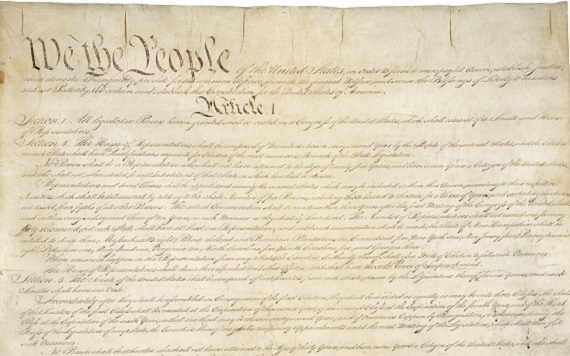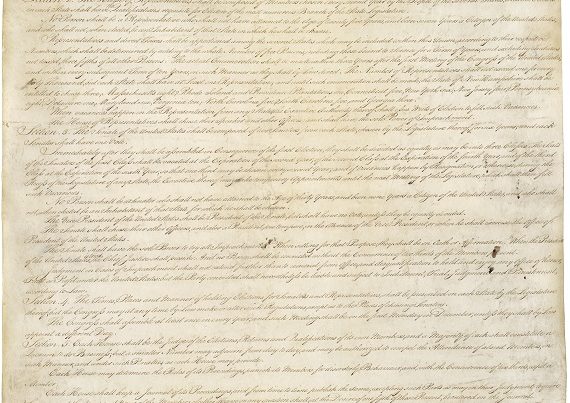On November 10, 2018, the Abbeville Institute hosted an event called The Revival of Nullification and Secession in Dallas, TX. The purpose was to educate people on the means by which we can escape the hatred and hostility that is consuming not only headlines, but our very souls. The population of these United States is split pretty much equally in terms of core political values, the Left/Right paradigm. When legislation over social issues, whether within the delegated powers (see Article I, sec. 8) or not, are handed down from Washington, D.C., matters intended to be left with the States become a matter of contention, nationwide. And as we are seeing now, contention is leading to violence.
There is talk of another Civil War, arguments over whether secession is a viable option to prevent such a scenario, but little cohesion when it comes to accurate and historical analysis of the problem, how it came to be, and how it may be resolved peacefully. The form of government we have now is the opposite of what was consented to by the States when they ratified the Constitution. Hampering efforts to “get back to the Constitution” is the fact that those we look to to get us there don’t understand the Constitution and what it was intended to do and more importantly, to prevent. Let’s examine briefly what was proposed and rejected, and what the States, when they ratified the Constitution, ultimately agreed to.
The Philadelphia Convention
In an attempt to resolve issues having arisen under the Articles of Confederation, delegates from the several States met in Philadelphia in the summer of 1787. However, rather than attempting to remedy these shortcomings, James Madison and Edmond Randolph proposed an entirely new solution: a strong, centralized government was the essence of this plan, an entirely new government. They called their proposal the Virginia Plan, which included a Federal negative (veto) over State legislation. The delegates in attendance representing their respective States rejected this proposal outright, as a usurpation of their sovereignty and independence. Delegates were so incensed, they threatened to end the convention altogether, so a compromise was reached that would result in a general government with enumerated powers, the balance remaining with the States.
James Madison admitted defeat and explained in Federalist 45 that “The powers delegated by the proposed Constitution to the federal government, are few and defined. Those which are to remain in the state governments are numerous and indefinite…The powers reserved to the several states will…concern the lives, liberties, and properties of the people, and the internal order, improvement, and the prosperity of the state.”
The States ratifying the Constitution understood that they were to retain their sovereignty and retain all powers except those not expressly delegated, and further, they could reclaim any powers delegated. Three states, Virginia, New York and Rhode Island specifically reserved their right to leave the voluntary union should they find it no longer suited their needs or desires; that reservation, once accepted, applied to all the States pursuant to the Equal Footing Doctrine. What does this mean? It means that secession was, and continues to be legal, according the the Constitution as ratified. It also means that any instances of State laws that were not prohibited to them, and not delegated to the general government were the business of the States exclusively.
To ensure confidence in the beneficent ends of the new government, a Bill of Rights was added. Certain rights, which predated the Constitution, were held so dear that it was not enough to simply omit them from the list of enumerated powers. Accordingly, the general government was expressly prohibited from making laws affecting certain natural, or God-given rights. This also served to acknowledge that the States had their own constitutions, which safeguarded these rights.
The Tenth Amendment makes this clear:
“The powers not delegated to the United States by the Constitution, nor prohibited by it to the States, are reserved to the States respectively, or to the people.”
Enter the National Government
What Congress was prohibited from doing at Philadelphia and the Ratification Conventions (the latter being our source for understanding what was agreed, or consented to), the Federal Judiciary now does on a regular basis – effectively veto (overturn) State legislation and State court holdings it finds disagreeable. But this was not always the case.
Even John Marshall, a supporter of a strong central government, was forced to admit, in Barron v. Baltimore 32 U. S. 243 (1833), that the first ten “amendments contain no expression indicating an intention to apply them to the state governments. This court cannot so apply them.”
It was not until 1925, in Gitlow v. New York 268 U. S. 652 that the Supreme Court magically “found” the authority to apply the Bill of Rights against the States supposedly hidden away in the 14th Amendment. This interpretation is both problematic and not supported by history. The 39th Congress, which proposed the amendment, did not intend to “incorporate” the Bill of Rights against the States, and no such premise had been adhered to in the preceding years.
By 1925, however, the Progressive Era was in full swing and the Supreme Court was well on its way to imposing a complete rewrite of the Constitution upon the States and the American people, thus diminishing the separation of powers between the States and the general government. So why does this continue?
The Problem with Lawyers
The history of the Philadelphia Convention and the ratification debates are available for anyone and everyone to read. Why, then, is this inversion of power acceptable? The answer lies in what I refer to as the “Malfeasance of the Legal Education Industry.” Many of our future lawmakers are lawyers, and their understanding of the Constitution derives not from studying the history I described above, but from studying “case law,” opinions handed down from a Left-leaning federal judiciary. Why does this matter? Because case law and the historical records are diametrically opposed in the vast majority of instances. Case law emanates from the opinions of Progressive Era judges in the 1930s, whose mission became one of acting as a rubber stamp for Franklin Delano Roosevelt’s New Deal policies, and using the Court as a means to force upon the States their policy preferences.
Aspiring lawyers study cases in which the Commerce Clause becomes the justification for broad swaths of federal overreach into areas of our lives never imagined by the framers and ratifiers. We are taught that from the Fourteenth Amendment, rights never before considered, spring forth from the Constitution, rights which must be enforceable against the States, in direct contravention to the Tenth Amendment. How do future lawyers reconcile these contradictions? They are taught to defer to the Fourteenth Amendment and ignore State sovereignty and limited government altogether.
High scores on exams are awarded for deferring to the rulings of the Federal Judiciary; in fact, bar review courses frequently tell hopeful candidates, for the multiple choice section of the exam to always, given the choice, choose the Fourteenth Amendment as an answer over the Tenth Amendment, for purposes of expediency. In other words, to become a lawyer, you must show that your comprehension of the system of government we have today is a complete inversion to that which the ratifying States consented. Practicing attorneys, in turn, must draft legal briefs that are also in direct conflict to historical records; we must claim our clients’ “Constitutional rights” in violation of the Pick-Your-Amendment have been violated, made applicable to the States, as if State constitutions simply do not exist.
Remember, this is the system that was rejected on each attempt; when a number of States insisted on a Bill of Rights as a condition of ratification, James Madison argued against it, as did Alexander Hamilton and James Wilson, among others. They argued it would be redundant since the general government only had the powers expressly granted.
The media perpetuates these myths by using law professors, rather than Constitutional historians, to explain how the Constitution applies to current events. Discussions turn to seeing what the “Supreme Court says” and the analysis is always flawed.
Nullification and secession are strategies by which we can peacefully resolve present contention; yet, those who look to the mainstream media and their correspondent lawyers will cite incorrect interpretations of the Supremacy Clause (Article VI) when Tenth Amendment arguments are raised, and Texas v. White 74 U. S. 700 (1869) when the issue of secession is raised.
For instance, when it came to light that acting Attorney General Matthew Whittaker said the following about nullification, “I think our founding fathers believed in nullification. There’s no doubt about that,”
CNN was quick to seek the wisdom of University of Texas law professor Stephen Vladeck. True to form, the professor described the statement as “irreconcilable not only with the structure of the Constitution, but…especially the text of the Supremacy Clause.” He continued by calling Mr. Whittaker’s views, given his position, “terrifying.” We live in a day when the principles of the Constitution as ratified are held by the media and legal “experts” as terrifying. Even more concerning is the fact that so many viewers believe it.
State sovereignty is ignored because of the ineptitude of the legal education system. Deference to the Supreme Court and a rogue Federal judiciary in contravention to principles of limited government and the preservation of liberty can also be credited to this system, where getting it backwards is rewarded at all levels – from classroom discussions, to examination grades, passing the Bar exam, and practicing law itself. The made-up incorporation doctrine has been the chief mechanism through which a one-size-fits-all form of government, with all rights and powers emanating from Washington, D.C., has arisen. It has been the springboard from which our Constitutional Republic has been systematically dismantled.
As for the ultimate vanguard of sovereignty and freedom from a tyrannical central government, the States and their right of secession, proponents of this option will be reprimanded with nonsense such as, “Lincoln settled that one!” or be told that “The Supreme Court ruled secession is illegal!” Given the history of the issue of secession, it would take a Constitutional Amendment to make it illegal; but decades of deference to the High Court has resulted in a de facto Article V convention every time they convene, only no one has invited the States.
The War for American Independence was fought to secure the natural right to be governed by a system to which the people have consented. Thanks to the indoctrination of future lawyers by Institutions staffed with individuals who have no excuse for their continued ignorance, the people and the States continue to defer to a system in which our fundamental, God-given, natural rights are determined, qualified, and restricted by a national government which no longer cares about the consent of the governed. We have come full circle, back to a system of Parliamentary Sovereignty; we have surrendered our revolutionary legacy.
Is there a Peaceful Solution?
Judging by what I experienced at the Abbeville Institute’s event, I can unequivocally say, “Yes!” Contrary to the hit piece by Casey Michel, from Think Progress, there was a tremendous sense of camaraderie among those who were in attendance, among both the Left and Right. Warmly embraced and welcomed (in fact, he received a standing ovation) was Marcus Ruiz Evans, a Liberal who founded YesCalifornia, part of the #CalExit movement. But you won’t hear about that from Mr. Michel. Why? Because Think Progress is all about Big Government, the antithesis to liberty. True freedom is anathema to organizations like Think Progress, who seek “control of the governed.” Mr. Michel ignored the presence of Marcus Ruiz Evans altogether. I can see why, given his warm welcome and the resounding positive response he received. Because the truth simply doesn’t fit his narrative, best ignore the Hispanic gentleman altogether, right?
Think Progress would prefer civil war to peaceful dissolution, yet they refer to Michael Boldin from the Tenth Amendment Center as an extremist. What secessionists have in common, on both sides, is the desire to exist under a system of “consent of the governed.” So we have two sides here: Think Progress, who prefers the status quo, even if it will lead to inevitable violence, and those seeking a peaceful solution where liberty can be realized and enjoyed by all. Now tell me, who is the extremist?







